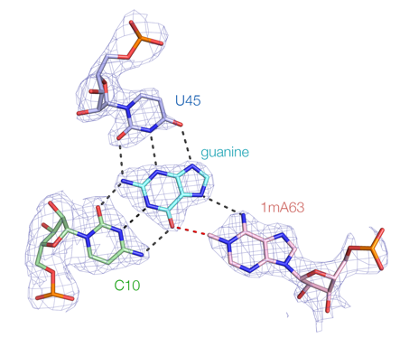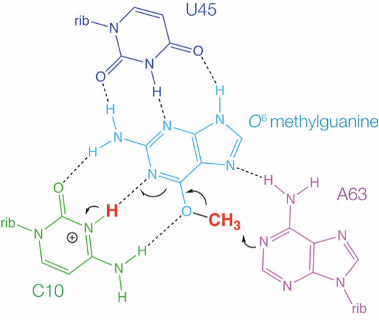David M.J.Lilley 2022-08-19
The RNA world hypothesis for the early development of life on the planet requires that RNA molecules (ribozymes) could have catalysed a wide variety of chemical reactions. Known ribozymes in contemporary biology carry out a limited range of chemical catalysis, mostly involving phosphoryl transfer, but in vitro selection has generated species catalysing a broader range of chemistry. To gauge the feasibility of an RNA world it is useful to explore if ribozymes can exploit sophisticated catalytic strategies.
A ribozyme has recently been selected that can catalyse a methyl transfer reaction using O6-methylguanine as donor. With Huang Lin’s lab have solved the crystal structure of this ribozyme at a resolution of 2.3 Å, showing how the RNA folds to generate a very specific binding site for the methyl donor substrate. The structure immediately suggests a catalytic mechanism, involving a combination of proximity and orientation, and nucleobase-mediated general acid catalysis. The mechanism is supported by the pH dependence of the rate of catalysis together with atomic mutagenesis and quantum mechanical calculation. This small chemical machine employs a relatively sophisticated catalytic mechanism, broadening the range of known RNA-catalysed chemistry. This lends new support to the RNA world hypothesis.
Going still further, how could RNA overcome its relative chemical simplicity and expand its catalytic repertoire? The RNA world would have required a much broader range of RNA catalyzed chemistry, including “difficult” reactions like making C-C bonds. Modern protein enzymes achieve this by using co-enzymes, and perhaps RNA could do the same. RNA is a superb receptor for small molecules, as exemplified by the riboswitches. A significant number of these bind coenzymes, including SAM, TPP, NAD+ and FMN, and it’s not a big leap to imagine that the riboswitch might have evolved from an ancient ribozyme, or might be converted into a novel ribozyme.
 |
 |
Deng et al.Structure and mechanism of a methyl transferase ribozyme Nature Chem Biol 18, 556–564 (2022)
David Lilley教授,英国皇家学会院士(Fellows of the Royal Society)、英国皇家化学学会会士(Fellow of the Royal Society of Chemistry),爱丁堡皇家学会会士(Fellow of the Royal Society of Edinburgh),欧洲分子生物学组织院士(Fellow of EMBO)。英国邓迪大学(University of Dundee)分子生物学教授,担任癌症研究所核酸结构研究组主任。曾获英国皇家化学学会跨学科奖、RNA和核酸化学奖等多个奖项。Lilley教授是核酸结构与功能领域的权威专家,历任Nucleic Acids Research、RNA等杂志编委,在Nature、Science、Cell等国际权威杂志上发表研究论文过400篇,目前被引次数28692次,高引用次数指数(h-index)93。主要研究RNA结构、ribozyme的结构和功能、DNA损伤修复等重要生命科学问题。
Royal Society of Chemistry Khorana Prize (2016)
RNA Society Lifetime Service Award (2015)
Royal Society of Chemistry, Interdisciplinary Award (2006)
RNA and Ribozyme Chemistry Award of The Royal Society of Chemistry (2002)
© 2022 Guangzhou RNA club.
We are part of the Guangzhou International Bioland.
Contact:
Building B2, Guangzhou Laboratory
96 Xingdao South Road, Guangzhou International Bio Island,
Haizhu District, Guangzhou, Guangdong, China. (Maps)